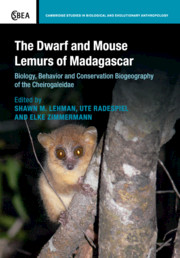 The Dwarf and Mouse Lemurs of Madagascar
The Dwarf and Mouse Lemurs of Madagascar from Part I - Cheirogaleidae: evolution, taxonomy, and genetics
Published online by Cambridge University Press: 05 March 2016
Introduction
Species divergence is driven by multiple factors, obfuscating the speciation mechanisms responsible for the diversity of life. The speciation mechanisms that dominate the literature are biogeographic models emphasizing allopatric speciation, or adaptive models invoking ecological adaptation and sexual selection (Coyne and Orr, 2004; Nosil, 2012). In the classic biogeographic model, vicariance is the dominant mechanism of speciation, in which previously interbreeding populations are sundered by a dispersal barrier (Ronquist, 1997; Ree and Smith, 2008; Ree and Sanmartín, 2009). The subdivided populations accumulate genetic differences due to drift, leading to reproductive isolation via genetic incompatibilities (Dobzhansky, 1937; Mayr, 1947; Orr, 1996). In the strict vicariant model, no divergent adaptation is necessary and the daughter species retain the niche of the ancestor, because their divergence was due to some physical dispersal barrier only (phylogenetic niche conservatism; Wiens et al., 2010). If the dispersal barriers disappear, the newly formed species may meet at contact zones, but species boundaries are maintained and hybridization is limited by genetic incompatibilities (Coyne and Orr, 1998).
In contrast, adaptive models, especially ecological speciation, posit that species diverge via local adaptation to different habitats (Nosil, 2012). Contact zones exist at parapatric species boundaries, such as in ecotones of the different habitats (Schluter, 2001). Hybridization may be limited by lower fitness of immigrants into suboptimal habitats (prezygotic), or by lower fitness of hybrids because they are maladapted to the preferred habitat of either parent species (postzygotic; Nosil et al., 2005). Immigrants into ecotones and suboptimal habitats may have lower fitness due to competition with neighboring, closely related species that are well adapted to that habitat (Bridle and Vines, 2007). Alternatively, immigrants into the neighbor species' habitats may exhibit ecological character displacement, altering their phenotypes and ecology to avoid competition and persist (Schluter, 2000; Case et al., 2005; Grant and Grant, 2006). The dynamics in contact zones offer an excellent opportunity to tease apart the subtle differences in geographic speciation mechanisms.
Speciation mechanisms related to behavior, especially sexual selection, are less frequently cited (Panhuis et al., 2001). Reinforcement is the positive selection for trait divergence driven by sexual selection and accentuated when closely related species are found in sympatry compared to in allopatry (Noor, 1999).
To save this book to your Kindle, first ensure [email protected] is added to your Approved Personal Document E-mail List under your Personal Document Settings on the Manage Your Content and Devices page of your Amazon account. Then enter the ‘name’ part of your Kindle email address below. Find out more about saving to your Kindle.
Note you can select to save to either the @free.kindle.com or @kindle.com variations. ‘@free.kindle.com’ emails are free but can only be saved to your device when it is connected to wi-fi. ‘@kindle.com’ emails can be delivered even when you are not connected to wi-fi, but note that service fees apply.
Find out more about the Kindle Personal Document Service.
To save content items to your account, please confirm that you agree to abide by our usage policies. If this is the first time you use this feature, you will be asked to authorise Cambridge Core to connect with your account. Find out more about saving content to Dropbox.
To save content items to your account, please confirm that you agree to abide by our usage policies. If this is the first time you use this feature, you will be asked to authorise Cambridge Core to connect with your account. Find out more about saving content to Google Drive.